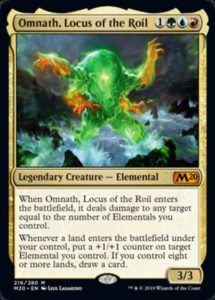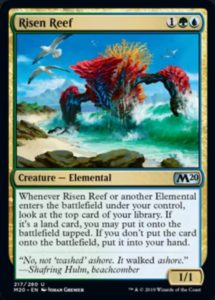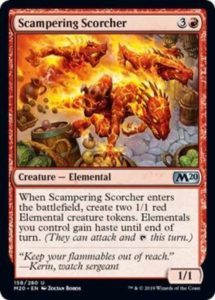Core Set 2020 releases this weekend and is already available on MTG Arena, meaning we’ve got a whole new format to explore! M20 seems to have a much higher power level and a lot more going on in its Limited format than did M19, so there’s a lot to think about.
The set has five macro-archetypes, but today we’ll focus on the most linear of them all: Temur Elementals. (The other four mechanics are much looser, from the mildly linear URW Fliers to the very modular BGU ETB Effects, WBG Go Wide, and RWB Aggro.) This is a tribe that hasn’t gotten much love since Lorwyn block, so it’s an exciting time to be an elementalist!
Paint with all the colors of the elements
In order to draft an archetype, one needs to know what colors and playstyles the archetype affords. In Core Set 2020, elementals are distributed through red, green, and blue. This means that there are three color pairs available to elemental drafters (in addition to playing all three): red-green, green-blue, and blue-red. Each of these color pairs unsurprisingly has access to different cards and accordingly supports different strategies and card evaluations. (Drafters of dinosaurs and pirates in Ixalan will remember this dynamic.)
Looking over each of the three colors, two things stand out. First, while there are a bunch of elementals, there are a pretty finite amount of elementals-matter cards—only seven cards specifically reference elementals, three of which are common. Chandra’s Embercat and Lavakin Brawler provide reasonable but not outstanding payoffs, and Thicket Crasher‘s ability is unlikely to do much. So, if you’re going to be drafting an elementals-matter deck, you’re either going to have powerful uncommons or you’re going to be playing red.
The second thing to notice is that there are zero monoblue cards that care about elementals. Instead, blue boasts a high density of solid playables that happen to be elementals, such as Cloudkin Seer (one of the best commons in the set), Frost Lynx, and Boreal Elemental. Blue being a powerful color with solid-on-their-own elementals both makes it a strong choice to draft (because you get to give great cards even more value) and a riskier one (because you’re fighting with every blue drafter at the table for these cards, whereas some red and green elementals are less desirable if you’re not committed to drafting the tribe).
Before going deeply into the cards themselves, we can tell a couple things. Red-green elementals decks have access to more synergy than do blue/x elementals decks. RG drafters are more likely to have access to the cards they need if they’re not fighting with anyone else. On the other hand, blue-based elementals decks get to have a more generically good cards. While they’ll be in competition with more people (on average), their drafts are less likely to fall apart if they’re missing some vital pieces.
The Archetypes
Each color pair has access to mana acceleration, five drops to accelerate into, and disruption. But there are some key differences in each of the color pairs.
Green-Blue is outstanding at turning elementals into cards with Risen Reef (a very powerful card and one of the most powerful uncommons in the set) and generating value with Overgrowth Elemental (another very strong engine). However, that’s all the synergy it has access to—if you’re missing these two crucial pieces, you’ve just got a goodstuff deck devoid of tribal synergy. In addition, blue-green has the most difficult time disrupting the opponent (which is usually the case), with removal like Unsummon (GU struggles to leverage tempo) and Rabid Bite (blue creatures are smaller than green and red’s). An overreliance on key pieces makes GU vulnerable to opponents’ disruption and cards like Silverback Shaman that produce card advantage. While green-blue has long been my favorite color combination and resolving Risen Reef into Cloudkin Seer feels basically like cheating, the archetype is fragile.
Blue-red has the best ability to outmaneuver opponents. This is highlighted by the UR signpost uncommon, Lightning Stormkin, a card with no elemental synergies. What this color combination lacks in overt engines, it can make up for with micro-synergies and flexibility. UR can combine Lavakin Brawler with cards like Frost Lynx to seize tempo. It can use Chandra’s Embercat to ramp out Boreal Elemental and play a midrange game with Chandra’s Outrage. It can even go hyper-aggressive with Scorch Spitter and Chandra, Novice Pyromancer, using Unsummon as a Path to Exile, since dead opponents can’t replay creatures.
The challenge of drafting blue-red well is deciding on your game plan while drafting—you’ll be best served by committing to at most two plans out of tempo, hyperaggro, and midrange. You have access to a lot of small payoffs but nothing as overt as Risen Reef, Overgrowth Elemental, or Creeping Trailblazer.
Red-green has the most elementals-matters cards, giving it the widest array of options. It boasts the largest creatures and best disruption, making it the best color combination for Rabid Bite. It has Creeping Trailblazer and Overgrowth Elemental to reward going wide and the game going long. It has enough ramp to actually cast Vorstclaw reliably and dominate the late game, but enough efficient creatures to apply pressure early.
The cost of these benefits is that RG lacks many of the overtly powerful elementals blue has, giving it more lackluster common elementals like Scorch Spitter, Fire Elemental, Healer of the Glade, and Vorstclaw. While you have access to the most payoffs, you have the fewest enablers and might have to put more than a few mediocre cards in your deck to get value out of your Overgrowth Elementals. Additional, you lack blue’s card draw, making you the least likely color pair to find the combination of enablers and rewards necessary for victory.
Core Set 2020 isn’t even out yet, but I’ve already had a bunch of fun grinding out opponents, looping creatures through the graveyard, and casting common Murders. It’s quite enjoyable seeing a Core Set designed for more enfranchised Limited play (something which was at most a tertiary priority for Core 2019) with so many powerful commons, synergies, and lenticular design, not to mention today’s fun and awesome-looking tribe. Here’s looking forward to a summer of Core 2020 and more Modern Horizons action, as well as the announcement of the fall set in two weeks.
And, as always, thanks for reading.
—Zachary Barash is a New York City-based game designer and the commissioner of Team Draft League. He designs for Kingdom Death: Monster, has a Game Design MFA from the NYU Game Center, and does freelance game design. When the stars align, he streams Magic (but the stars align way less often than he’d like).
His favorite card of the month is Tajuru Pathwarden. It’s a unique combination of numbers that’d never been done before in quite that way and was one of a few cards that turned green from the worst color in Battle for Zendikar into one of the stronger colors in Oath of the Gatewatch. It can be really nice when a french vanilla creature does a lot of work.




